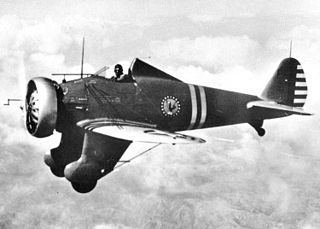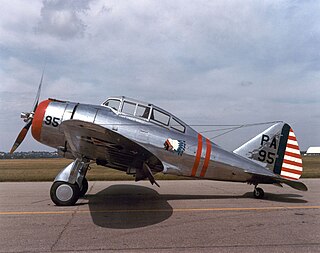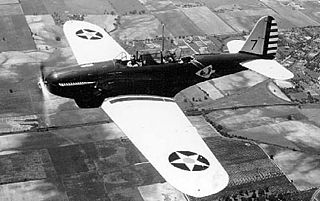
The Boeing P-26 "Peashooter" was the first American production all-metal fighter aircraft and the first pursuit monoplane to enter squadron service with the United States Army Air Corps. Designed and built by Boeing, the prototype first flew in 1932, and the type was still in use with the U.S. Army Air Corps as late as 1941 in the Philippines. There are two surviving Peashooters, but there are three reproductions on display with two more under construction.

Alexander Kartveli, born Aleksandre Kartvelishvili, was a Georgian aeronautical engineer and an aviation pioneer in the United States. Kartveli achieved important breakthroughs in military aviation in the time of turbojet fighters.

The Curtiss P-36 Hawk, also known as the Curtiss Hawk Model 75, is an American-designed and built fighter aircraft of the 1930s and 40s. A contemporary of the Hawker Hurricane and Messerschmitt Bf 109, it was one of the first of a new generation of combat aircraft—a sleek monoplane design with a retractable undercarriage making extensive use of metal in its construction.

The Seversky P-35 is an American fighter aircraft built by the Seversky Aircraft Company in the late 1930s. A contemporary of the Hawker Hurricane and Messerschmitt Bf 109, the P-35 was the first single-seat fighter in United States Army Air Corps to feature all-metal construction, retractable landing gear, and an enclosed cockpit.

The Seversky XP-41 was a fighter aircraft built in the United States in 1939. A single prototype was modified from the last production Seversky P-35 by adding a new streamlined canopy, a Pratt & Whitney R-1830-19 engine with a two-speed supercharger, and revised landing gear. The XP-41 first flew in March 1939. The aircraft was developed in parallel with the P-43 Lancer, and work was stopped when the USAAC showed a preference for the latter.

Alexander Nikolaievich Prokofiev de Seversky was a Russian-American aviation pioneer, inventor, and influential advocate of strategic air power.

The Republic P-43 Lancer was a single-engine, all-metal, low-wing monoplane fighter aircraft built by Republic, first delivered to the United States Army Air Corps in 1940. A proposed development was the P-44 Rocket. While not a particularly outstanding fighter, the P-43A had a very good high-altitude performance coupled with an effective oxygen system. Fast and well-armed with excellent long-range capabilities, until the arrival of the Lockheed P-38 Lightning, the Lancer was the only American fighter capable of catching a Japanese Mitsubishi Ki-46 "Dinah" reconnaissance plane at the speeds and heights at which they flew. In addition, the P-43 flew many long-range, high-altitude photo recon missions until replaced by F-4/F-5 Lightnings in both the USAAF and RAAF.

The Ryan STs were a series of two seat, low-wing monoplane aircraft built in the United States by the Ryan Aeronautical Company. They were used as sport aircraft, as well as trainers by flying schools and the militaries of several countries.

The Curtiss-Wright Model 21 was an American fighter-interceptor developed by the St. Louis Airplane Division of Curtiss-Wright Corporation during the 1930s.

The Grumman XP-50 was a land-based development of the shipboard XF5F-1 Skyrocket fighter, entered into a United States Army Air Corps (USAAC) contest for a twin-engine heavy interceptor aircraft. The USAAC placed an order for a prototype on 25 November 1939, designating it XP-50, but it lost the competition to the Lockheed XP-49.

The North American P-64 was the designation assigned by the United States Army Air Corps (USAAC) to the North American Aviation NA-68 fighter, an upgraded variant of the NA-50 developed during the late 1930s. Seven NA-50s were purchased by the Peruvian Air Force, which nicknamed it Torito.

The North American Aviation NA-16 was the first trainer aircraft built by North American Aviation, and was the beginning of a line of closely related North American trainer aircraft that would eventually number more than 17,000 examples, notably the T-6 Texan family.

The Grumman FF "Fifi" was an American biplane fighter aircraft operated by the United States Navy during the 1930s. It was the first carrier aircraft with retractable landing gear. It was produced under licence in Canada and known as the Goblin in Canadian service and Delfín in Spanish service.

The Northrop Gamma was a single-engine all-metal monoplane cargo aircraft used in the 1930s. Towards the end of its service life, it was developed into the A-17 light bomber.

The Consolidated P-30 (PB-2) was a 1930s United States two-seat fighter aircraft. An attack version called the A-11 was also built, along with two Y1P-25 prototypes and YP-27, Y1P-28, and XP-33 proposals. The P-30 is significant for being the first fighter in United States Army Air Corps service to have retractable landing gear, an enclosed and heated cockpit for the pilot, and an exhaust-driven turbo-supercharger for altitude operation.

The Curtiss-Wright CW-22 was a 1940s American general-purpose advanced training monoplane aircraft built by the Curtiss-Wright Corporation. It was operated by the United States Navy as a scout trainer with the designation SNC-1 Falcon.

The Curtiss Fledgling, known internally to Curtiss as the Model 48 and Model 51 was a trainer aircraft developed for the United States Navy in the late 1920s and known in that service as the N2C.

The Seversky SEV-3 was an American three-seat amphibian monoplane, the first aircraft designed and built by the Seversky Aircraft Corporation.

The Vought V-141 was a prototype American single-seat fighter aircraft of the 1930s. It was a development of the unsuccessful Northrop 3-A design, but was itself a failure, being rejected by the United States Army Air Corps. The sole prototype was sold to the Japanese Army in 1937, but no production followed, with the type proving to be inferior to existing Japanese fighters.




















